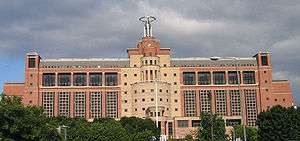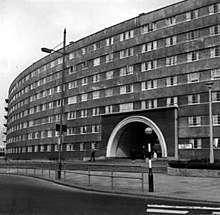Quarry Hill, Leeds
Coordinates: 53°47′53″N 1°31′52″W / 53.798°N 1.531°W


Quarry Hill is an area of central Leeds, West Yorkshire, England. It is bounded by the Leeds Inner Ring Road in the east and north and the Leeds – York / Hull railway in the south. The area falls within the City and Hunslet ward of Leeds City Council.
History
Quarry Hill was originally an inner-city area of Leeds.
Three churches have historically been located on Quarry Hill. The Old Boggart House was the first purpose built Methodist chapel in Leeds.[1] It was demolished following the opening of the adjacent St Peter's Chapel in 1834. The site is marked by a blue plaque on the steps leading to the Leeds Playhouse. Quarry Hill Ebenezer Primitive Methodist chapel, originally called "Chapel Street Chapel", was opened in 1822,[2] new frontage was added in 1846 and the chapel was enlarged in 1874. It closed in 1933.[3] St Mary's Church,[4] a Commissioners' Church, architect Thomas Taylor,[5] was located on St Mary's Street. Located on the top of the hill, looking over New York Road towards the city centre, and known both as "St. Mary's Mabgate" and "St. Mary's Quarry Hill",[6] the site is now a Diocesan Office. The Sunday school remains, as does the burial ground, a green area sloping down to Mabgate.
Between 1938 and 1978 Quarry Hill was the location of what was at the time the largest social housing complex in the United Kingdom. The building was designed in 1934 by R. A. H. Livett (1898–1959), the Director of Housing and later City Architect for Leeds. Its design was influenced strongly by modernist developments in Europe, specifically the Karl-Marx-Hof in Vienna, Austria, and La Cité de la Muette in Paris, France.[7] The development was noted for its sheer size and modernist design. It had then radical and modern features such as solid fuel ranges, electric lighting, a state-of-the-art refuse disposal system (Garchey) and communal facilities including a swimming pool.[8] Due to social problems and poor maintenance, the Quarry Hill Flats were demolished in 1978.[9]
Current
Since the 1980s, Quarry Hill has been a focus for regeneration within Leeds, and today is home to the West Yorkshire Playhouse, now known as Leeds Playhouse, which opened in 1990, Yorkshire Dance[10] established in 1982,[11] Quarry House (a Department of Health and Department for Work and Pensions building with a social/leisure complex, which opened in 1993), the BBC Yorkshire building, the Leeds College of Music and the Northern Ballet building which opened in 2010. Centenary Square and the Playhouse Square are located at Quarry Hill. The regeneration has seen Quarry Hill become disassociated with East Leeds, and become part of central Leeds.
Quarry House was constructed on the site of the former Quarry Hill Flats.[12]
Leeds City College is building a creative arts and health, care and public services campus, designed by Ellis Williams Architects, on the north-west of the site, which is scheduled to open in September 2019.[13]
In the media
- The flats were shown in the opening sequence of the popular 1970s sit-com Queenie's Castle (1970–72) which starred Diana Dors.[14][15]
- Featured in the Peter May novel Runaway, with scenes set in the housing project in 1965 and in its later transformation circa 2015.
- Quarry Hill also features in Charles Stross's 2016 novel The Nightmare Stacks.
- The complete Quarry Hill development in architects model form can be seen in the 1935 film "Housing Problems" which is featured as an extra on BBC DVD release of the influential 1966 TV play Cathy Come Home.
Further reading
References
- ↑ Methodists celebrate 200 years of Mission, accessed 17 July 2018
- ↑ Ross, H., Quarry Hill P.M. Church, Leeds – A Centenary Sketch: Transcription of Article in the Primitive Methodist Magazine by Rev. H. Ross, Primitive Methodist Magazine, 1922/456, accessed 17 July 2018
- ↑ Hill, C., Quarry Hill Ebenezer Primitive Methodist chapel, accessed 3 July 2017
- ↑ Yorkshire Evening Post 07 Oct 2010: Seven lost wonders of Leeds
- ↑ Green, E., Dr. Hook's Missing Churches: The vanishing legacy of Victorian church architecture in Leeds, The Building Conservation Directory and Historic Churches, accessed 4 July 2017
- ↑ Leodis, a photographic archive of Leeds, St Mary's Church, accessed 4 July 2017
- ↑ Wrathmell, Susan (2005). Leeds. New Haven: Yale University Press. p. 171. ISBN 9780300107364.
- ↑ http://www.yorkshireeveningpost.co.uk/your-leeds/nostalgia/leeds-nostalgia-memories-of-quarry-hill-flats-almost-40-years-on-1-8369587
- ↑ http://www.bbc.co.uk/leeds/citylife/quarry_hill/history.shtml
- ↑ "Yorkshire Dance – contact us". Yorkshire Dance. Retrieved 21 February 2018.
- ↑ Javin, Val (11 October 2012). "Yorkshire Dance needs you to help celebrate its 30th birthday". Huddersfield Examiner. Retrieved 21 February 2018.
- ↑ "Footbridge over York Road Flyover, Inner Ring Road (during construction of Quarry House)". Loedis.net. Retrieved 1 February 2009.
- ↑ Leeds City College, Quarry Hill Campus, accessed 3 October 2018
- ↑ Wainwright, Martin (4 October 2004). "My Leeds". The Guardian. London. p. 14.
- ↑ "Slideshow: Hidden six decades, RAF's eye view of Leeds". Weekly News. Leeds. 9 October 2013.